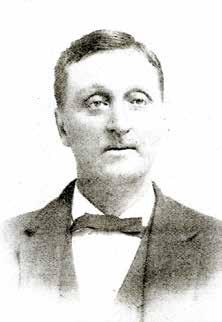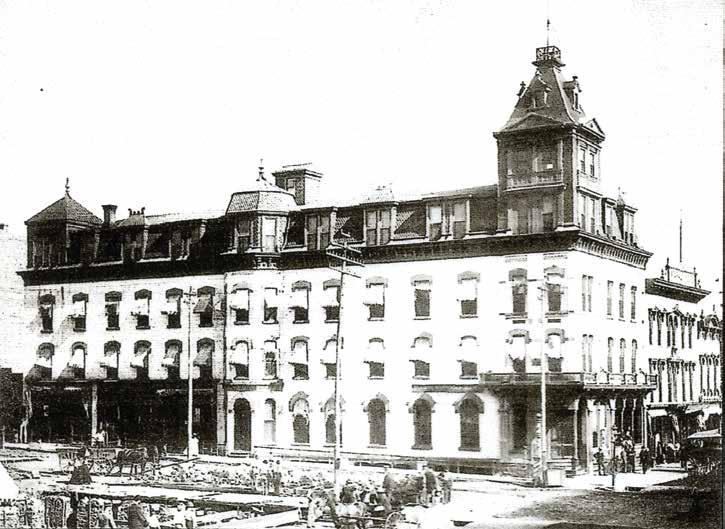
5 minute read
The Cataract Hotel
title
Third Cataract Hotel

The Cataract Hotel
BY WAYNE FANEBUST
In the early 1870s, Sioux Falls, Dakota Territory, was in the midst of a second attempt to become a town, after the first site created by speculators, in 1857, was abandoned and destroyed in 1862 — as a direct consequence of the Dakota War in Minnesota. In 1865, the federal government located a military post called Fort Dakota on the ruins of the first town site. The area was thought of as too valuable to ignore and in 1870, when the government shut down the installation and withdrew the troops, eager prairie entrepreneurs took up the challenge of starting over. W. H. Corson was among the ambitious pioneers.
“Harry” Corson, as he was called by his fellow frontier residents, was from Maine. Having been born in a hotel, he seemed destined to claim that line of work. Harry was eight years old, when his family moved to Monroe, Wisconsin, where his father engaged in the mercantile trade. At age 23, he went west to California where he ran a hotel, among other businesses. In 1870, Harry Corson came to Sioux Falls, and after taking a good look at the area, decided that people would come, a city would be built, and as such, a hotel would be a wise investment.


Harry Corson

First Cataract Hotel
Corson chose a portion of the old military camp grounds as the site of the first bona fide hotel in Sioux Falls. On the northwest corner of 9th Street and Phillips Avenue, he opened a modest hotel, called the Cataract, to the traveling public in August of 1871. It featured 14 sleeping rooms and two parlors, and within a relatively short period of time, gained the reputation as the “best hotel in Dakota Territory.” Harry boasted that his hotel was clean and had no bugs. It also became the stopping point for the Yankton to Sioux Falls stagecoach.
No doubt Harry Corson named it the Cataract because of the falls of the Big Sioux River that noisily cascaded over the massive chunks of quartzite stone, within a short distance of the new hotel. That bonus that patrons could hear the roar of the falls at night was the charm of patronizing the quiet Cataract Hotel.
In 1878, Harry was joined by his brother Henry T. Corson and the two men formed a partnership in the hotel business. That same year the brothers built an addition on the north side of the original frame hotel. Business was good, so in 1880, the brothers decided to build bigger. The original wooden structure was moved on


Second Cataract Hotel
to 9th Street and later to South Duluth Avenue where it was converted to an apartment house.
A strange thing happened while the old hotel was in the process of being moved from its foundation to the street. A distinguished guest had not been informed of the intended relocation and was scared out of his wits when the walls of his room began to shake, creak and groan, as the building was inched off its foundation. It was a bizarre but humorous incident that kept the old-timers talking about it until there were no old-timers left to remember.
The original hotel stayed in business on 9th Street until a new one, constructed with brick, was opened up to the traveling public. Designed by the famed architect, Wallace Dow, the new and much larger hotel opened in December of 1882. It was in every detail a magnificent and elegant addition to downtown Sioux Falls. It had 100 rooms, heated by steam, hot and cold running water, gas, electric lights and every modern convenience. Rooms rented for $2.00 and $2.50 per day. The genial and tactful Corson brothers had placed a crown jewel on the head their adopted city.
Business was good at the new Cataract and the intersection of 9th Street and Phillips Avenue became the heart of the city and the center of the business district. “Meet me at the Cataract,” became the welcoming expression on the lips of deal makers, politicians, business men and society ladies. The Cataract’s reputation grew steadily over the years until it had become one of the best hotels in the West. South Dakota achieved statehood in 1889, and along with that elevated status, the state featured lenient, divorcefriendly laws. These laws did not escape


the attention of divorce-minded people in other parts of the country. Soon well-known wealthy people from all over America were coming to Sioux Falls to establish the sixmonth residence requirement in order to get a divorce. Many of these social elites chose the Cataract Hotel to reside while waiting out the legal process. These people helped to create South Dakota’s reputation as the “Divorce Colony” of America, with the luxurious Cataract Hotel as its headquarters.
Then on the night of June 30, 1900, the unthinkable happened; fireworks in a nearby store ignited a fire that destroyed the Cataract Hotel. All those divorcees who had taken residence there had to find other accommodations and longtime Sioux Falls residents were forced to consider facing the future without a familiar piece of the past. For many folks, there had always been the Cataract and to their relief, a third iteration of the iconic hotel was built, designed by Sioux Falls architect, Joseph Schwarz.
The new 160-room hotel opened in 1901, and the Cataract’s popularity resumed as if there was a hint of institutional permanence at the corner of 9th Street and Phillips Avenue. Among its distinguished guests were Senator Robert F. Kennedy, Eleanor Roosevelt, pianist Liberace, actor Broderick Crawford, and band leaders Les Brown and Stan Kenton. The classy hotel must have played host to many a great party. But all the fun ended in 1972, when the hotel was demolished by the crush of something called urban renewal. Sadly, the grand old Cataract Hotel, with all its secrets and memories, died its last death. It succumbed to the wrecking ball and was thereby unceremoniously consigned to history. May it be long and well remembered.
at home 21
Life on the Lake
man in the kitchen 30
Spring Forward!
vino 34
5 Steps
recipes 40
Easter Treats
knick knacks of life 42
It’s Spring… and I Don’t Need to Clean
health & well-being 44
How to Learn Your Own Breast Density and Cancer Risk
nest






